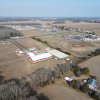Traffic and weather buzz as summer 2014 peaks
You can thank the Northern Hemisphere jet stream for the nice weather we’ve been having this summer. According to AccuWeather Senior Meteorologist Paul Walker, the cool jet stream air that flows from west to east across North America stayed well to the north of us last summer. That means the cold fronts associated with the jet stream also stayed to the north of us. “The last couple of years we got into that warm, humid air, and it stuck around longer than normal,” said Walker. “This year the jet stream is slipping to the south, and that’s bringing more extremes in our weather in terms of warm spells followed by cooler and drier air.” Based on 30-year averages, said Walker, “This is closer to a normal summer.”
He said our region has seen many more cold fronts coming through, like the one he said he expected at the end of this week. “They give us a break from the humidity,” said Walker. “By Friday we’ll be having a nice day.”
I’ve mentioned, a couple of times this summer, reports of an El Niño weather phenomenon taking shape in the southern Pacific. “We’re starting to see signs of it,” said Walker. “We usually see its effects more in the winter months. If the El Niño develops as it typically does, it will affect the track of winter storms.” He said for our region, we could see a warmer-than-normal winter with more rain storms as opposed to “those wintry precipitation events. It just depends on how strong the El Niño is.” He said we should know by September whether and how strong an El Niño event lies ahead.
Walker said this summer has seen a number of cool air masses settling in for a few days, dropping temperatures at night sometimes into the high 50s and lower 60s. “It looks like we may have another cool mass coming our way for a few days at the end of July into early August.”
Better weather, more traffic?
Earlier this summer we published a story indicating the number of injuries suffered by swimmers in the surf zone was way up this year compared to 2013. I have a theory. Could it be that we have a lot more people in the ocean this year because we’ve had so many weekends with nice weather compared to last year? More people in the ocean equals more possible injuries? (Remember, never turn your back on the waves.)
DelDOT officials told me this week that we’re in the peak of the peak season right now, and given our overall road conditions, congestion is and should be expected. “The good news,” said Mark Lusztz, “is that the beaches are a popular place, and people want to come to them. We’re constantly monitoring traffic and tweaking the timing of lights to make traveling as efficient as possible.”
Lusztz works in DelDOT’s Traffic Management Control section headquartered along Route 1 in Smyrna. He said he really doesn’t have a sense of what the overall traffic flows are like this summer compared to other years. “My sense is it’s nothing extraordinary. We’re seeing what happens in southeastern Sussex every summer. Of course there is more traffic now in the off-season, but right now, from Independence Day until the middle of August, we’re in the peak of the peak.”
Lusztz said Delaware implemented new highway technology called a Traffic Responsive System last year. “Route 1 in the beach area is the first place we implemented the system,” he said. The system gathers data from microwave detectors, loops in the road surface, and, increasingly, Bluetooth detectors. That data, said Lusztz, is then factored into real-time calculations to automatically adjust cycle times on traffic signals. He said the Bluetooth detectors allow the system to anonymously track vehicles with Bluetooth on board to see how fast they’re traveling through various areas. “In responsive mode there’s much less hand managing of the system, and it’s definitely improving things. We don’t have to tinker on a day-to-day or hour-to-hour basis. I’d say we’re improving our efficiency on the roads by 5, 10 or up to 15 percent. But we have lots of lanes and lots of cross traffic. There’s only so much we can do.”
Lusztz said drivers with smartphones and iPads should take advantage of a free DelDOT app that gives them access to some of the same information traffic managers are using. “Just search for DelDOT app on your phone or go to DelDOT.gov to download. The app features interactive maps and real-time travel times that people can use in their planning.” He said the app will tell drivers what the normal driving time is between two locations and what that expected time will be - in real time - when the highways are congested. “The more informed people are when they’re making decisions, the better,” said Lusztz.
Although DelDOT is receiving more data all the time, they haven’t been able to analyze it yet to determine, for instance, whether traffic flows are greater or less this year than last. “We haven’t found the time yet to crunch all this data for better planning.”
Lusztz, however, doesn’t need any more data to characterize Route 1 between Lewes and Rehoboth Beach in the summertime. “It’s an interesting corridor,” he said. “When it’s nice weather, there are more day trippers and that means more traffic. Then when it’s cloudy and rainy, everyone goes insane and heads to the outlets and there’s even more traffic. And like I said before, that’s a good problem to have.”
When a summer comes along when we don’t have congestion and backups during the peak season, that’s when we’ll have a bad problem.
























































